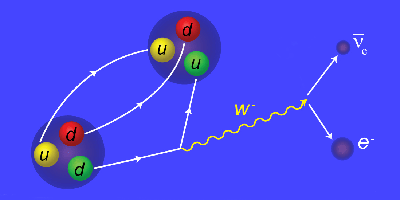December 6, 2013 report
Reevaluation of 2005 measurement deepens mystery of neutron lifetime discrepancy

(Phys.org) —A team of researchers from a variety of institutions in the U.S. has reevaluated a measurement made of the lifetime of a neutron back in 2005 and in doing so has reduced the uncertainty of the accuracy of the measurement made—unfortunately it's also led to an increase in the lifetime that was being measured. This, the researchers note in their paper published in Physical Review Letters, only increases the discrepancy between it and lifetime measurements made using another technique.
Neutrons normally exist inside the nucleus of an atom. If the nucleus is stable, the lifetime of the neutron is theoretically forever. Outside of a nucleus, however, things are very different. Due to interactions with other bits of matter, neutrons decay to other particles after about 15 minutes. Physicists and other scientists would like to nail down that decay to a very precise number—doing so would help in developing theories about what occurred just after the Big Bang, for example. The problem is, scientists currently have just two different ways to measure the decay and the answers the two return differ by so much that either the measuring techniques have to be improved, or the theories changed to reflect a different reality. Current research is leaning, quite naturally, towards the first approach.
The two different types of measuring techniques are: the bottle method (trapping some neutrons in a bottle and counting how many are left after some time has passed) and the beam method (creating a beam of neutrons and then counting how many decay over a period of time over a given distance). Until this latest research effort, the most accurate measurements using both techniques were performed in 2005. A team in the U.S. worked on the beam method while a team in Russia worked on the bottle method. Unfortunately, the two measurement results differed from one another by eight seconds. In this new effort, the researchers sought to improve the accuracy of their measurement, which they assumed would narrow the gap between the two results. Things didn't work out that way. Instead, the team did get a more accurate result (from ±3.2s to ±1.9s), but they also got a different lifetime measurement—one that was 3.8σ, instead of 2.9σ, the measurement found in 2005.
This new result hasn't caused physicists to revisit physics theories just yet, instead, most believe the problem is still in the accuracy of measurement—it needs to be below 1s for both before such measurements can be taken seriously. That means, someone will have to redo the bottle method, even as others continue to refine the beam method.
More information: Improved Determination of the Neutron Lifetime, Phys. Rev. Lett. 111, 222501 (2013) prl.aps.org/abstract/PRL/v111/i22/e222501
Journal information: Physical Review Letters
© 2013 Phys.org



















